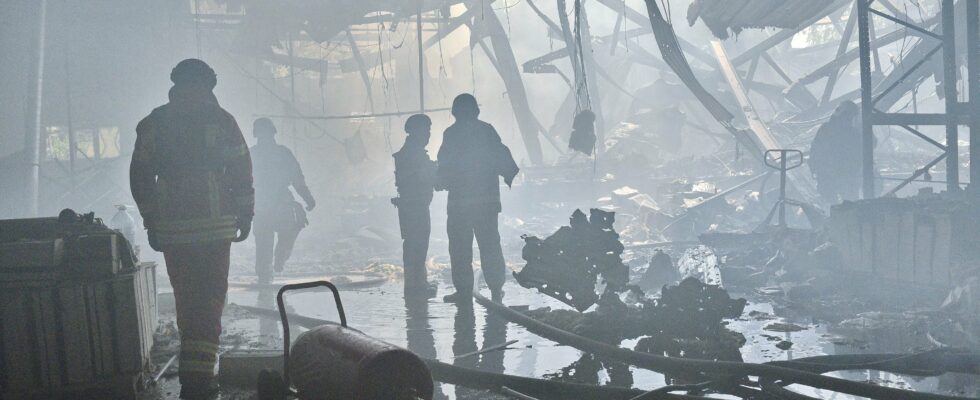In Kharkiv, around thirty kilometers from the Russian border, bombings are almost daily. Since Moscow launched a new offensive in northern Ukraine on May 10, this metropolis, the second largest city in Ukraine and capital of the region of the same name, has once again become a favored target of the Russian army. , increasing day after day the macabre count of civilian victims. On May 23, at least seven people died and sixteen injured in an attack on a printing press.
“Russian terrorists are taking advantage of the fact that Ukraine does not have sufficient air defense protection as well as our lack of reliable capabilities to destroy their launchers which are located near our borders,” denounced the same day Volodymyr Zelensky, asking for “more determination” from his allies.
Among other things, in the Ukrainian president’s sights, the rule which prohibits his army from using Western military equipment to strike targets located in Russia. Behind this caution, at work since the start of the conflict, the fear of “the risk of escalation” with Moscow, maintains a French diplomatic source. Problem: where Russia suffers no limitations with regard to the material it receives from North Korea or Iran, this approach leads Ukraine to fight with one hand behind its back. “Russian planes are attacking our territory with glide bombs dropped from Russia and we have few means to respond,” points out Mykhailo Gonchar, president of the Ukrainian institute Center for Global Studies Strategy XXI. This is why we are asking permission to use Western missiles to attack Russian airfields near our borders and repel enemy aircraft.”
“We made the mistake of limiting the Ukrainians”
For lack of anything better, the Ukrainian forces have until now had to limit their means of striking deep into Russia to drones of their own making. “They have tinkered with several types of aircraft, but it is neither the precision nor the efficiency of Western armament, summarizes General Nicolas Richoux, former commander of the 7th armored brigade. Indirectly, this allows the Russians to mass troops near the Ukrainian borders without being really threatened.”
The recent opening of a new front in the North has only amplified kyiv’s difficulties. And in the process, criticism against this restriction imposed on his army. “From the beginning, we made the mistake of limiting the Ukrainians because it could be considered an escalation,” lamented May 20 on LCI Lithuanian Foreign Minister Gabrielius Landsbergis. Only one side has imposed rules. We must abandon these rules that we have created.” The day before, the president of the Foreign Affairs Committee of the French National Assembly, Jean-Louis Bourlanges, had affirmed that Russian territory should no longer be “sanctuaryized”.
At this stage, only the United Kingdom officially took the plunge, attracting the wrath of Moscow three days later. “All British military installations and equipment on the territory of Ukraine and abroad” could be targeted, the Russian Foreign Ministry warned on May 6. Despite this first British initiative, it is above all a change of heart from Washington – by far the main supplier of arms to Ukraine – that kyiv is hoping for. If, during his trip to Ukraine at the beginning of May, Secretary of State Antony Blinken seemed to initiate a change in the American posture by affirming that it was up to kyiv “to make its decisions on the way in which it conducts this war”, the State Department qualified its remarks the next day and reiterated that it would not “encourage or allow strikes on Russian territory”.
The fight at the borders, a handicap for Ukraine
The pressure nevertheless continues to grow across the Atlantic. On May 20, a bipartisan group of US lawmakers sent a letter to US Defense Secretary Lloyd Austin, asking him to authorize “under certain circumstances” the use of US weapons against “strategic targets within of Russian territory. The day before, former Acting Deputy Secretary of State Victoria Nuland had also called for a review of the American posture during an interview on the channel ABC. Despite these multiple requests, kyiv remains expectant. “So far, there is nothing positive,” Volodymyr Zelensky said on May 21 in an interview with Reuterswhile confirming that negotiations had been initiated on the issue with its international partners.
Do they have a chance of succeeding? “Over the course of the conflict, several taboos ended up being broken, including that on the delivery of heavy tanks and then combat planes,” recalls Thibault Fouillet, scientific director of the Institute for Strategy and Defense Studies. we cannot exclude that the same is true for this rule.” In the meantime, the Russian army continues to play its cards. As it had done before opening a front in the Kharkiv region, it would have started to amass troops near the border region of Sumy, in northern Ukraine, mid-war warned. May the head of Ukrainian military intelligence Kyrylo Budanov. “The Russians have understood that fighting at the borders handicaps their adversary, so they want to exploit the niche,” points out General Richoux. For the Ukrainian forces, time is running out.
.
